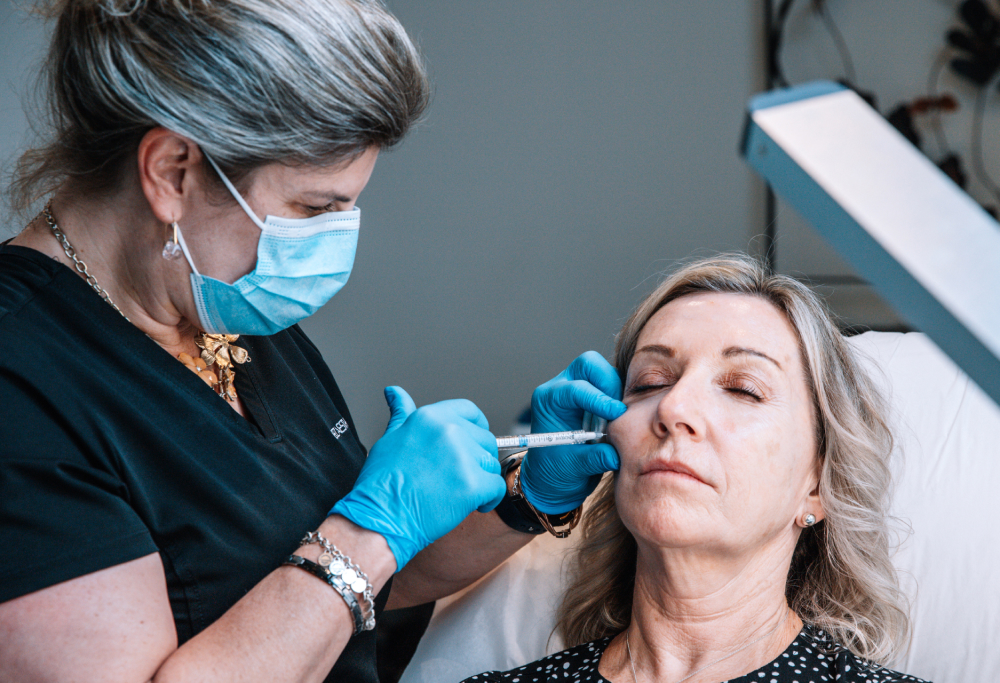blog
The Difference Between Lid Ptosis and Brow Ptosis and How to Treat Them

Mar 25 2022
Reading Time: 5 Minutes
Author: Patricia Pezzano
Brows or eyelids that feel heavy after a Botox injection, having trouble to fully open the eyes, and droopy eyelids or brows — these are all signs of ptosis.
Ptosis is when the eyelids or brows droop because of congenital muscle disorders, injury or trauma, age, and nerve and connection problems around the eyes. Some of these cases can be fixed through surgery.
However, ptosis can also occur as a side effect of Botox treatment. About 2 percent of people who get a Botox injection may experience ptosis, especially when an untrained individual administers the injection. This probability declines to 1 percent when a skilled healthcare professional does the procedure.
But how could Botox cause lid ptosis and brow ptosis? Considering their similarities, how would you know whether it’s the former or the latter? And what are the treatment options for the two conditions?
We’ll discuss all the answers to these questions below.

Understanding How Botox Works
Botox is a neurotoxic protein injected into the muscles to temporarily block certain signals that cause muscles to contract. This treatment, which lasts about three to four months, prevents wrinkles from forming. Simply said, it blocks a chemical your muscles need to contract, without that chemical, they relax.
Performing Botox injections can be tricky because everyone has different facial muscle movements. Doctors and healthcare professionals need to ensure that the toxin will only affect the specific target muscles. Thus, they need to make an educated decision on how much, where and how deep to inject to prevent surface migration of the toxin.
How Does Lid Ptosis Happen After Botox?
Well-trained doctors and nurses know exactly where to inject Botox and how deep it should go down based on their understanding of the anatomy. They have been properly trained and have sufficient experience so side effects like ptosis can be avoided.
So, how does lid ptosis happen?
A person who wants to lessen the appearance of frown lines — those lines that look like number “11” above the nose — is injected with Botox between the eyes.
However, very occasionally, the toxin can migrate into the upper eyelids and inactivate the levator palpebrae, the muscle that holds the upper eyelids up. That is the reason patients are asked not to touch or rub the areas that have been injected for four hours after an injection. This allows the muscle carefully injected by the physician or nurse to pick up the product without having it moved into a muscle they did not want to inject.
When the levator palpebrae is inactivated, the eyelids will droop and lifting the eyelid becomes troublesome. This is why it’s crucial that only properly trained healthcare professionals administer Botox injections.

Lid ptosis is very uncommon in aesthetic injections. It is more common when Botox is used for a condition called blepharospasm which is uncontrolled spasm of the orbicularis oculi, the muscle around your eye. When treating this condition, the injection points are vastly different than when treating a frown line and may have a higher risk of causing lid ptosis. But overall, lid ptosis from cosmetic injection is very rare.
If this does happen, the effect is temporary and treatment is available.
How Does Brow Ptosis Happen After Botox?
To lessen the appearance of forehead wrinkles, Botox is injected into the forehead to prevent the frontalis muscle — the muscle that raises the eyebrows — from contracting. When done successfully, Botox should give the appearance of a smooth forehead.
However, brow ptosis or brow droop happens when either too high a dose is given or it is injected too low into the frontalis muscle. This causes an excessive relaxation of the muscle and since the normal activity of the muscle is to “lift” it now can not lift and the eyebrows lack expression.
Also, forehead lines shouldn’t be treated without treating the glabellar complex first (the muscle under the frontalis). If you over-relax the frontalis or forehead muscle and leave the glabellar complex active, brow ptosis is more likely. This is because the glabellar complex normally pulls the eyebrows down. So, if it is left active (can pull down) but the forehead is treated and therefore can not pull it, the risk of brow ptosis is higher.
Again, this typically happens when the Botox injection is administered by a person who lacks training or experience.
Brow ptosis doesn’t just happen after a bad Botox injection. It can also occur in people with pre-existing lid ptosis. Because lid ptosis usually hinders the upper-vision field, the brain sends a signal to the forehead muscles to compensate and maximize eyelid elevation.
However, brow or forehead elevation can’t be maintained for too long, so the forehead muscles tend to relax after a while. Repeatedly elevating and relaxing the forehead muscles stretches the ligaments. With age, this causes the brows to droop.
Lid and Brow Ptosis Treatment
Lid and brow ptosis from Botox usually appears a few days to a week after being injected. Usually, it gets better after three to four weeks.
There are several things that can be done to get the eyelids or brows back to normal faster. Some of these include:
-
Eyedrops for Lid Ptosis
Using 0.5% of a special eyedrop called äpraclonidine every three to four hours stimulates a muscle called “Mueller’s muscle.” This muscle also helps raise the eyelid and can minimize the look of lid ptosis. This medication should only be used if instructed by a healthcare specialist.
-
Brow Lift for Brow Ptosis
If the lids feel heavy as a result of brow ptosis or overrelaxation of the frontalis muscle, then the practitioner will make sure there is no activity in the glabellar complex (that would make the brow ptosis look worse) and would give a patient a brow lift to help raise the brow.
Both lid and brow ptosis are temporary conditions that resolve on their own — even with no further treatment.
How Do I Know if Lid Heaviness Is Caused by Lid Ptosis or Brow Ptosis?
Patients often confuse brow droop with eyelid droop and vice-versa after Botox. So if a patient complains of lid heaviness a few days after Botox injection, what should you do? How can you tell if it’s lid or brow ptosis?
Ask the Patient to Relax Their Face
Ask the patient to relax their face. If the face is at rest and one or both the eyelids are drooping, then the patient has lid ptosis.
On the other hand, if the lids aren’t drooping but the brows have lost their arch, it’s an indication that the patient has brow ptosis.
Ask the Patient to Raise Their Eyebrows
If you ask the patient to raise their eyebrows, but the face still looks like it’s at rest, chances are the patient has brow ptosis. They have lost the ability to raise their brows because of an inactive frontalis.
Ask the Patient to Frown
This will help you determine if the patient has active glabellar activity. An active glabella will worsen brow ptosis. Inject the glabella complex to lift the brows as needed.
Also, healthcare professionals have to remember that the full effects of Botox injections won’t be seen until after 14 days. It could look uneven prior to that, so it’s best to wait. What looks uneven today can look perfect the next day.

Become a Certified Botox Expert with APT Injection Training
Botox injections are relatively safe and lid or brow ptosis can easily be avoided — but only when they’re performed by a certified healthcare professional.
APT Injection Training will give you the skills you need to safely and effectively perform Botox injections. We are the only facility in Canada that offers International Certification in Aesthetic Injectable Therapies, such as Botox injections. When you train with us, you can rest assured that you’ll be equipped with the necessary skills to be a master injector.
Contact us today or visit our website to learn more about our Botox training courses.
Tips to be a
Successful Injector!
Free E-Book download
 Student Log in
Student Log in
 1267 Cornwall Rd, Unit 300, Oakville, Ontario L6J 7T5
1267 Cornwall Rd, Unit 300, Oakville, Ontario L6J 7T5

 (289) 271-5718
(289) 271-5718




































